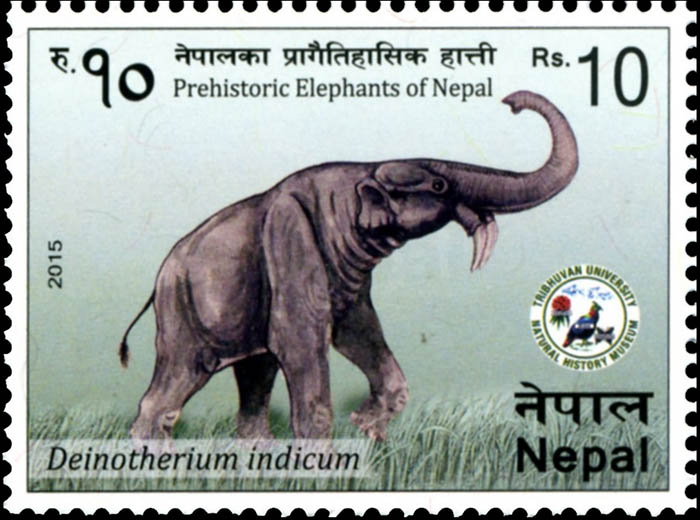Deinotherium indicum Falconer 1845

(Da: en.wikipedia.org)
Phylum: Chordata Haeckel, 1874
Subphylum: Vertebrata Cuvier, 1812
Classe: Mammalia Linnaeus, 1758
Ordine: Proboscidea Illiger, 1810
Famiglia: Deinotheriidae Bonaparte, 1845
Genere: Deinotherium Kaup, 1829
Specie e sottospecie
Il genere annovera attualmente le seguenti specie: Deinotherium bozasi Arambourg, 1934 . Deinotherium giganteum Kaup, 1829 - Deinotherium indicum Falconer, 1845 - Deinotherium? Levius Jourdan, 1861 = Deinotherium? Proavum Eichwald, 1831.
Descrizione
Si distingue dalla specie europea Deinotherium giganteus Kaup 1829 per la dentatura più robusta. Questa specie apparve nel Miocene medio, e fu molto comune per tutto il Miocene superiore. Scomparve proprio alla fine del periodo, circa 7 milioni di anni fa.
Diffusione
È la specie asiatica, rinvenuta in India e Pakistan
Bibliografia
–Kovachev, Dimitar; Nikolov, Ivan (2006). "Deinotherium thraceiensis sp. nov. from the Miocene near Ezerovo, Plovdiv District" (PDF). Geologica Balcanica. 35 (3-4): 5-40.
–Antunes, M.T.; Ginsburg, L. (2003). "The Deinotherium (Proboscidea, Mammalia): an abnormal tusk from Lisbon, the Miocene record in Portugal and the first appearance datum. Evidence from Lisbon, Portugal" (PDF). Ciencias da Terra. 15: 173-190.
–Markov, G. N.; Spassov, N.; Simeonovski, C. (2001). "A reconstruction of the facial morphology and feeding behaviour of the deinotheres". The World of Elephants. Proceedings of the 1st International Congress: 652-655.
–Huttunen, K. (2002). "Systematics and Taxonomy of the European Deinotheriidae (Proboscidea, Mammalia)" (PDF). Annalen des Naturhistorischen Museums zu Wien. 103: 237-250.Larramendi, A. (2016). "Shoulder height, body mass and shape of proboscideans" (PDF). Acta Palaeontologica Polonica. 61.
–Hutchinson, J. R.; Delmer, C.; Miller, C. E.; Hildebrandt, T.; Pitsillides, A. A.; Boyde, A. (2011). "From Flat Foot to Fat Foot: Structure, Ontogeny, Function, and Evolution of Elephant "Sixth Toes."" (PDF). Science. 334 (6063): 1699-1703.
–Gagliardi, Fanny; Maridet, Olivier; Becker, Damien (2020). "The record of Deinotheriidae from the Miocene of the Swiss Jura Mountains (Jura Canton, Switzerland)". bioRxiv.
–Delmer, C. (2009). "Reassessment of the generic attribution of Numidotherium savagei and the homologies of lower incisors in proboscideans". Acta Palaeontologica Polonica. 54 (4): 561-580.
–Poulakakis, N.; Lymberakis, P.; Fassoulas, C. (2005). "Deinotherium giganteum (Proboscidea, Deinotheriidae) from the Late Miocene of Crete". Journal of Vertebrate Paleontology. 25 (3): 732-736.
–Markov, G.N.; Spassov, N.; Simeonovski, C. (2002). "Reconstruction of the facial morphology of Deinotherium gigantissimum Stefanescu, 1892 based on the material from Ezerovo, South Bulgaria" (PDF). Historia Naturalis Bulgarica. 14: 141-144.
–Göhlich, U.B. (2010). "Tertiäre Urelefanten aus Deutschland". Elefantenreich – Eine Fossilwelt in Europa. pp. 340-372.
–Harris, J. M. (2009). "Cranial and dental remains of Deinotherium bozasi (Mammalia: Proboscidea) from East Rudolf, Kenya". Journal of Zoology. 178 (1): 57-75.
–Pickford, Martin; Pourabrishami, Zeinolabedin (2013). "Deciphering Dinotheriensande deinotheriid diversity". Palaeobiodiversity and Palaeoenvironments. 93 (2): 121-150.
–Athanassiou, A. (2004). "On a Deinotherium (Proboscidea) finding in the Neogene of Crete". Carnets Geol. 4 (5).
–Singh, N. P.; Jukar, A. M.; Patnaik, R.; Sharma, K. M.; Singh, N. A.; Singh, Y. P. (2020). "The first specimen of Deinotherium indicum (Mammalia, Proboscidea, Deinotheriidae) from the late Miocene of Kutch, India". Journal of Paleontology. 94 (4): 1-8.
–Alba, D. M.; Gasamans, N.; Pons-Monjo, G.; Luján, À. H.; Robles, J. M.; Obradó, P.; Casanovas-Vilar, I. (2020). "Oldest Deinotherium proavum from Europe". Journal of Vertebrate Paleontology. 40 (2): e1775624.
–Konidaris, G. E.; Roussiakis, S. J.; Athanassiou, A.; Theodorou, G. E. (2017). "Reprint of: The huge-sized deinothere Deinotherium proavum (Proboscidea, Mammalia) from the Late Miocene localities Pikermi and Halmyropotamos (Greece)". Quaternary International. 445: 5-22.
–Vergiev, S.; Markov, G. N. (2010). "A mandible of Deinotherium (Mammalia: Proboscidea) from Aksakovo near Varna, Northeast Bulgaria". Paleodiversity. 3: 241-247.
–Ameen, M.; Khan, A. M.; Ahmad, R. M.; Iqbal, A.; Akhtar, M. (2021). "Appraisal of dental enamel hypoplasia in the middle Miocene Deinotheriidae: implications of the Siwalik paleoenvironment of Pakistan". Revista Brasileira de Paleontologia. 24 (4): 357-368.
–Zhan-Xiang, Qiu; Ban-Yue, Wang; Hong, Li; Tao, Deng; Yan, Sun (2007). "First discovery of deinothere in China". Vertebrata PalAsiatica. 45 (4): 261-277.
–Sankhyan, A. R.; Sharma, S. L. (2014). "In situ dental remains of Deinotherium from Northwest Indian Siwaliks". Himalayan Geology. 35 (1): 75-81.
–Aiglstorfer, Manuela; Bocherens, Hervé; Böhme, Madelaine (2014). "Large mammal ecology in the late Middle Miocene Gratkorn locality (Austria)". Palaeobiodiversity and Palaeoenvironments. 94 (1): 189-213.
–Tessy, Pascal (1990). "The "Proboscidean Datum Event:" How Many Proboscideans and How Many Events?". European Neogene Mammal Chronology. NATO ASI Series (Series A: Life Sciences). Vol. 180. Springer. pp. 237-252.

|
Data: 07/07/2015
Emissione: Elefanti preistorici del Nepal Stato: Nepal |
|---|